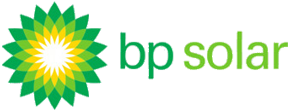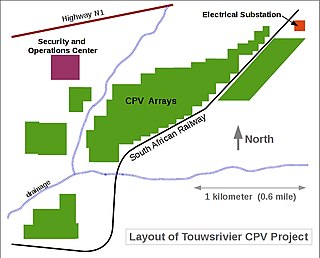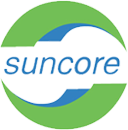Soitec is an international company based in France, that manufactures substrates used in the creation of semiconductors.
Nanosolar was a developer of solar power technology. Based in San Jose, CA, Nanosolar developed and briefly commercialized a low-cost printable solar cell manufacturing process. The company started selling thin-film CIGS panels mid-December 2007, and planned to sell them at 99 cents per watt, much below the market at the time. However, prices for solar panels made of crystalline silicon declined significantly during the following years, reducing most of Nanosolar's cost advantage. By February 2013 Nanosolar had laid off 75% of its work force. Nanosolar began auctioning off its equipment in August 2013. Co-Founder of Nanosolar Martin Roscheisen stated on his personal blog that nanosolar "ultimately failed commercially." and that he would not enter this industry again because of slow-development cycle, complex production problems and the impact of cheap Chinese solar power production. Nanosolar ultimately produced less than 50 MW of solar power capacity despite having raised more than $400 million in investment.

BP Solar was a manufacturer and installer of photovoltaic solar cells headquartered in Madrid, Spain, with production facilities in Frederick, MD, India and the People's Republic of China. It was a subsidiary of BP.
SunEdison, Inc. is a renewable energy company headquartered in the U.S. In addition to developing, building, owning, and operating solar power plants and wind energy plants, it also manufactures high purity polysilicon, monocrystalline silicon ingots, silicon wafers, solar modules, solar energy systems, and solar module racking systems. Originally a silicon-wafer manufacturer established in 1959 as the Monsanto Electronic Materials Company, the company was sold by Monsanto in 1989.
Global Solar Energy is a US-based manufacturer of CIGS solar cells, a thin-film based photovoltaic technology, with manufacturing operations in Tucson, Arizona, United States, and Berlin, Germany. In 2013, it was bought by Chinese renewable energy company Hanergy.
Concentrix Solar GmbH was a German solar power company based in Freiburg, Germany, that specialized in developing and commercializing concentrator photovoltaics (CPV) technology. In December 2009, Concentrix Solar was acquired by the French Soitec Group. In January 2015, Soitec announced its intention to exit from the CPV business, citing a lack of sales due to competition from lower-cost conventional photovoltaics. An agreed sale of the business to Chinese firm ConcenSolar in May 2015 was not completed. In January 2017, the technology and manufacturing assets were acquired by Saint-Augustin Canada Electric.
Zenith Solar was an Israeli solar energy company based in Ness Ziona.

The use of solar energy began in Israel in the 1950s with the development by Levi Yissar of a solar water heater to address the energy shortages that plagued the new country. By 1967 around 5% of water of households were solar heated and 50,000 solar heaters had been sold. With the 1970s oil crisis, Harry Zvi Tabor developed the prototype of the solar water heater now used in over 90% of Israeli homes. There are over 1.3 million solar water heaters installed as a result of mandatory solar water heating regulations.

Between 1992 and 2023, the worldwide usage of photovoltaics (PV) increased exponentially. During this period, it evolved from a niche market of small-scale applications to a mainstream electricity source. From 2016-2022 it has seen an annual capacity and production growth rate of around 26%- doubling approximately every three years.

Concentrator photovoltaics (CPV) is a photovoltaic technology that generates electricity from sunlight. Unlike conventional photovoltaic systems, it uses lenses or curved mirrors to focus sunlight onto small, highly efficient, multi-junction (MJ) solar cells. In addition, CPV systems often use solar trackers and sometimes a cooling system to further increase their efficiency.
Amonix, Inc. is a solar power system developer based in Seal Beach, California. The company manufactures concentrator photovoltaic (CPV) products designed for installation in sunny and dry climates. CPV products convert sunlight into electrical energy in the same way that conventional solar photovoltaic technology does, except that they use optics to focus the solar radiation before the light is absorbed by solar cells. According to a comparative study of energy production of solar technologies, CPV systems require no water for energy production and produce more energy per megawatt (MW) installed than traditional PV systems. Amonix has nearly 70 megawatts of CPV solar power systems deployed globally, including Southwestern U.S. and Spain. In May 2012, the Alamosa Solar Generating project, owned and operated by Cogentrix Energy, began commercial operation. This is the largest CPV power plant in the world and is expected to produce enough clean renewable energy per year to power more than 6,500 homes and will avoid the emissions of over 43,000 metric tons of carbon dioxide per year. The Alamosa Solar Generating Project is supported by a power purchase agreement (PPA), which is a long-term agreement to sell the power it will generate. Under the project's PPA, the Public Service Company of Colorado will buy the power generated by the solar facility for the next 20 years. In July 2012, Amonix set the world record for photovoltaic module efficiency at 33.5% under nominal operating conditions, verified by the National Renewable Energy Laboratory. In April 2013, Amonix broke the record set in July 2012, demonstrating photovoltaic module efficiency at 34.9% under normal concentrator standard operating conditions, also verified by the National Renewable Energy Laboratory. In August 2013, Amonix announced it had achieved a 35.9% photovoltaic module efficiency rating under concentrator standard test conditions (CSTC) as calculated by NREL. In June, 2014, the assets of Amonix were acquired by Arzon Solar, LLC for the purpose of continued development of CPV technology and products.
Hanergy Holding Group Ltd. (Hanergy) is a Chinese multinational company headquartered in Beijing. The company is focusing on thin-film solar value chain, including manufacturing and solar parks development. It also owns the Jinanqiao Hydroelectric Power Station and two wind farms.

LONGi Green Energy Technology Co. Ltd. or LONGi Group (隆基股份), formerly Xi'an Longi Silicon Materials Corporation, is a Chinese photovoltaics company, a major manufacturer of solar modules and a developer of solar power projects.

Touwsrivier CPV Solar Project is a 44 MWp (36 MWAC) concentrator photovoltaics (CPV) power station located 13 km outside the town of Touwsrivier in the Western Cape of South Africa. The installation reached full capacity in December 2014 and is the second largest operating CPV facility in the world. Electricity produced by the plant is fed into the national grid operated by Eskom under a 20-year power purchase agreement (PPA).
The Newberry Springs CPV Power Plant is a 1.68 MWp (1.5 MWAC) concentrator photovoltaics (CPV) power station in Newberry Springs, California. It was built by Blattner Energy using 60 dual-axis CX-S530 systems, each of which contains 12 CX-M500 modules. Each module contains 2,400 Fresnel lenses to concentrate sunlight 500 times onto multi-junction solar cells, allowing a greater efficiency than other photovoltaic power plants. The output is being sold to Southern California Edison under a 20-year Power Purchase Agreement.
The Eubank Landfill Solar Array is a photovoltaic power station in Albuquerque, New Mexico that consists of 1.0 MWAC of concentrator photovoltaics (CPV) and 1.0 MWAC of flat-panel silicon photovoltaics (PV). It is the only utility-scale CPV system utilizing Suncore third-generation technology that is operational and grid-connected in the US. A portion of the output is being sold to PNM under a Power Purchase Agreement.
The Questa Solar Facility is a 1.17 MWp (1.0 MWAC) concentrator photovoltaics (CPV) power station in Questa, New Mexico. Upon its completion in late 2010, it was one of the largest CPV facilities in the world, and the first utility-scale installation of Concentrix Solar technology in the United States. Annual electricity production is expected to average about 2.1 GW·h, and is being sold to the Kit Carson Electric Cooperative under a 20-year power purchase agreement (PPA).
Golmud CPV Solar Park is a 138 MWp (~110 MWAC) concentrator photovoltaics power station located near Golmud City in Haixi Prefecture, Qinghai Province, China. It is the largest operating CPV facility in the world, and was constructed in two phases by Suncore Photovoltaics starting in 2012. It is situated at an elevation of about 2,800 meters (9,200 ft) on the Tibetan plateau near the Gobi Desert with several other conventional photovoltaic power stations.
The Fort Churchill Solar Array is a 19.9 megawatt (MWAC) concentrator photovoltaics power station near the city of Yerington in Lyon County, Nevada. It is the largest assembly of SunPower C7 tracker low concentration PV (LCPV) technology in the United States. The facility was constructed for Apple Inc. to service its Reno Technology Park Data Center.




